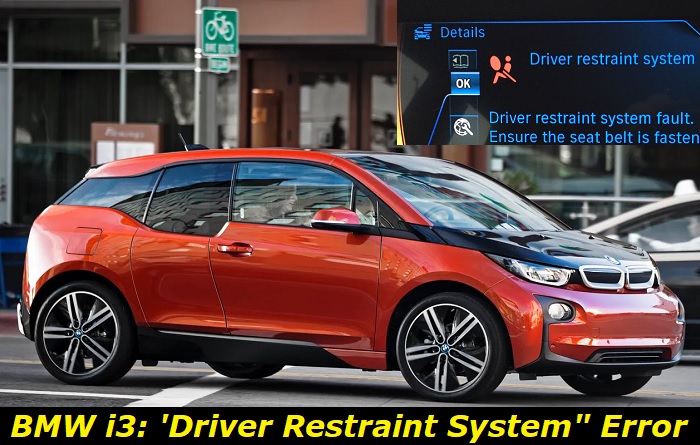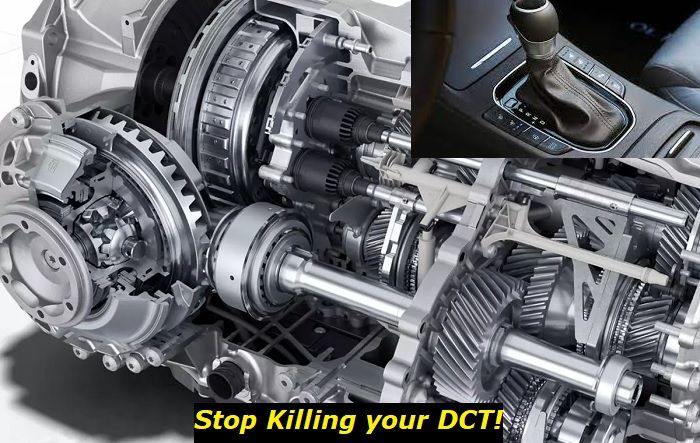No BMW i3 owner could sleep peacefully with a Driver Restraint System error message on the dashboard.
Driver restraint system malfunction message highlights
- Common reasons:water damage to seat sensor, seat belt issues, other safety system problems
- How to fix:replace the seat sensor, verify the seat belt is OK, use a good scanner tool
- Possible consequences:airbags on the driver's side not deploying when needed
- Priority level:High
- Can you drive?Yes
- DIY repair:Impossible
- Repair price range:$150-$500

According to National Highway Traffic Safety Administration (NHTSA), frontal vehicle airbags saved about 50,457 people in 2017. And that airbags in proper condition could reduce driver fatalities by 29%. Another study shows that driving with seatbelts, even without airbags, can reduce fatality risks by up to 50%.
But what if this message suddenly displays on your dashboard?
All these inconveniences can appear at random times when you are driving or performing some regular maintenance on your BMW i3.
- After cleaning the driver's seat
- After you spilled on the driver's seat
- After moving the driver seat and putting it back
- After replacing your 12V battery
You seemingly haven't done anything wrong. But maybe some connectors, fuses, or sensors were affected after running errands in your car.
And since the situation is risky, you have to find out what problem prompts the driver restraint system alert. In this article, we compiled possible causes of your restraint system malfunction.
How BMW i3 Driver Restraint System Works?
Your BMW i3 is a system designed to reduce the impact of collisions and crashes during accidents. It absorbs the impact or force of the crash and secures the vehicle's occupant to its pre-impact direction.
When your BMW i3 undergoes an accident, its speed or direction behaves differently. Your Primary Restraint System (the seatbelt) and Supplemental Restraint System (the airbag) detect crash pulses or deceleration through their sensors.
These sensors decide when to deploy airbags. For high-impact and sufficient deceleration, the system deploys airbags within 20 milliseconds. Driver seats can have multiple airbags on the knees, fronts, and sides. At most times, when the impact is high, these airbags deploy instantly at the same time.
If the impact is low, your BMW i3 driver restraint system may deploy the pre-tensioners of your seatbelt.
If your Driver Restraint System works properly, your chances of suffering high-impact crashes and acquiring injuries will reduce.
Driver Restraint System Malfunction in BMW i3 dashboard-What does it Mean?
- A damaged sensor on the driver's seat
This issue is one of the most common problems in the driver restraint system because the driver seat is always in contact with the passenger.
Your driver seat, including your passenger seats, has sensor mats sewn under your seat's upholstery. This sensor acts in the event of car crashes. It decides according to the weight and size of the person seating it.
In the event of irregularity, it decides whether to deploy airbags from the side, knees, or front.
However, getting in contact with this sensor would disrupt its position in the upholstery. If you have spilled any liquid above your driver seat upholstery and cleaned it, you may find the driver restraint system message in your dashboard.
- Faulty wiring connections
Wiring connections are another common issue for the BMW i3 driver restraint system.
Your BMW i3 has wire harness connectors plugged into different vehicle parts. Your driver's seat has them under it. At the same time, your connector issue could be on the other end. And it would be difficult to find which connectors have bad connections. Your Restraint System has over 100 error codes, so you need a scanner to determine the location of the defective wiring harness connector.
But if you can visibly find them under the driver's seat, all you need to do is unplug the connector and plug it in.
If you have a damaged wire harness, you will need to replace it. Go to your BMW parts shop and find the affected cable parts recommended in the Electronic Parts Catalogue (EPC). That is if you are confident with wirings. But if not, it better have a technician look into it.
These wirings get loose when moving the driver seat. So, it pays to check these wirings regularly and see if they are plugged in correctly. When these connectors obtain damage or loosen, expect the Driver Restraint System warning on your dashboard.
- Excessive resistance
Excessive resistance happens when the short jumper harness cable ties between the steering clock spring and airbag create tension. Airbags should have around 2 ohms of resistance. Anything above or lower than required is out of spec.
You'll never know this issue until you see your airbag lights pop and bring your i3 to your service shop. There had been a massive recall for units 2014-2016 i3 and 2014-2016 i3 Range Extender for faulty airbag assembly. But most of them have been fixed already.
Having excessive resistance causes a malfunction in the airbag inflator. It can cause the airbags to deploy unnecessarily or not deploy in low-impact collisions.
- BST cables issues
The Battery Safety Terminal (BST) is a safety mechanism for BMW vehicles used to minimize the risk of having electrical fires during a collision. The airbag control module operates this mechanism which consists of an explosive charge and cables supplying power to the engine bay. It activates the explosive charge during a collision and terminates the connection of the battery and cables connected to the engine bay.
There are two cable connectors from the power supply. One connects to other parts, and the other connects to the BTS, which means all other modules work with a power supply passing in BTS. Otherwise, these modules will not work. If your BST mechanism activates, you will now be driving with a driver restraint system alert on your dashboard. Replace your BST, or this alert stays on.
- Power connection issues and low voltage
The terminal cables, positive and negative, connected to the battery can go broken or loose. It disrupts the function of the BST and all other modules connected to it with low voltage or no power. These cables often loosen during battery replacement. The excessive bending and twisting during replacement displace the ends of battery cables from the taper.
To avoid this, do not use an electric screwdriver or impact driver as they can have the excessive force and overtighten the cables.
- Seatbelt issues
Your seatbelt is your first defense against collisions or crashes. It's the restraint mechanism that has direct contact with your body. According to NHTSA, seatbelts saved about 14,955 people in 2017. For this reason, seatbelts became the primary restraint system.
The common problems with seatbelts are faulty tensioners and defective seatbelt force limiters.
Let's talk about the faulty tensioner first. Your seatbelt has a pre-tensioner that either locks or tightens the slack during a collision. Ideally, your seatbelt should be snug fit when worn and buckles snappingly when locked.
The female part of the belt that snaps the buckle on utilizes an explosive charge that houses a piston with sensors to detect collision. As soon as it detects an accident, this piston rolls the spool around against the belt's material to retract the entire belt and secure the occupant on its seat.
When the pre-tensioner fails, it can result in the belt too slacking, not holding the occupant secure enough to reduce or prevent impact to panels, windshield, steering wheel, and vehicle ejection.
As the name implies, a belt force limiter decreases the amount of seat belt force in the event of a collision. When the impact is high, and the belt force is not pre-defined, it can result in upper body injuries. All this is possible with the help of the torsion bar, which helps adjust the belt force to a pre-defined level.
With a faulty tensioner or belt force limiter in your seatbelts, you are risking seatbelts extending longer, which will not be helpful in crashes.
How Can You Diagnose a Problem in your BMW i3 Restraint System?
You can try resetting your car's battery by unplugging the cables for about three minutes and plugging them back. If your car does not start, you may have power supply issues. Remember that some modules rely on your BST. Expect a Driver Restraint System message on your dashboard when driving with low voltage or power cable problems. You can try testing the cables with a multimeter for power.
Or, you can try checking the wires under your driver's seat. If you have recently tried to move it back and forth, you must have displaced the connectors.
If you have recently cleaned your seat, you must have disturbed the sensor pads.
But if the error message comes with airbag lights on, that changes when you move your steering wheels, never attempt to fix or test the airbag assembly.
The best thing you can do to know the problem in your Driver Restraint System is to bring your BMW i3 to trusted service professionals for error code scanning. This way, you can find which wires are components are affected.
Can you Drive with your Driver Restraint System Light on the Dashboard?
It depends on the issue. Even if you can drive the car with the restraint system alert, know that you risk safety.
Driving with excessive resistance may risk deploying the airbags when not needed. Or it may not deploy the airbag when it needs to.
Here's what you can do to care for your Driver Restraint System. Avoid drinking beverages and eating chips and crumbs while in the driver's seat. Or at least ensure these little things do not go under your driver's seat. Most restraint system problems come from low voltage, faulty sensors, and bad connectors.
Moreover, make it a habit to bring them to your trusted mechanic for maintenance and inspection. Remember, always drive safely.
About the authors
The CarAraC research team is composed of seasoned auto mechanics and automotive industry professionals, including individuals with advanced degrees and certifications in their field. Our team members boast prestigious credentials, reflecting their extensive knowledge and skills. These qualifications include: IMI: Institute of the Motor Industry, ASE-Certified Master Automobile Technicians; Coventry University, Graduate of MA in Automotive Journalism; Politecnico di Torino, Italy, MS Automotive Engineering; Ss. Cyril and Methodius University in Skopje, Mechanical University in Skopje; TOC Automotive College; DHA Suffa University, Department of Mechanical Engineering






Add comment